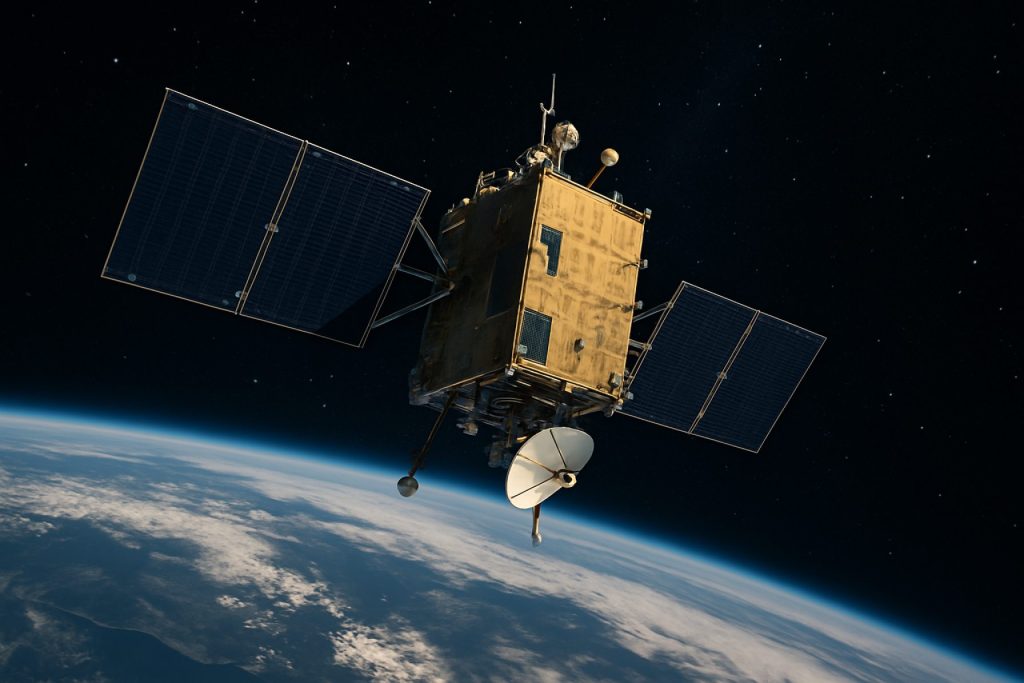
Inside America’s Silent Sentinels: Unmasking the Strategic Impact of GSSAP on Space Domain Awareness
- GSSAP and the Evolving Landscape of Space Surveillance
- Emerging Technologies Shaping GSSAP Capabilities
- Key Players and Strategic Dynamics in Space Surveillance
- Projected Expansion and Investment in GSSAP Initiatives
- Geopolitical Hotspots and Regional Implications of GSSAP
- Anticipating the Next Phase of Space Surveillance Operations
- Navigating Barriers and Unlocking Potential in GSSAP Deployment
- Sources & References
“High above Earth, in the crowded expanse of geosynchronous orbit (GEO) some 22,300 miles up, a set of American satellites quietly keeps watch.” (source)
GSSAP and the Evolving Landscape of Space Surveillance
The Geosynchronous Space Situational Awareness Program (GSSAP) represents a pivotal advancement in the United States’ ability to monitor and protect its assets in geosynchronous orbit (GEO). Launched by the U.S. Space Force, GSSAP satellites operate in near-geosynchronous orbits, providing persistent, close-up surveillance of objects in this critical region, which is home to many of the world’s most valuable communication, weather, and military satellites.
Unlike traditional ground-based sensors, GSSAP satellites can maneuver to observe objects from multiple angles, offering a unique vantage point for characterizing and tracking satellites and debris. This capability is crucial as the GEO belt becomes increasingly congested and contested, with over 500 operational satellites and growing concerns about space debris and potential adversarial actions (Space.com).
- Stealth and Proximity: GSSAP satellites are designed for discretion, operating without publicized orbital parameters. They can approach other satellites closely, gathering high-resolution imagery and data without detection, which is vital for both security and intelligence purposes (SpaceNews).
- Operational Impact: Since the first pair launched in 2014, GSSAP has enabled the U.S. to detect unannounced satellite maneuvers, identify potential threats, and attribute suspicious activities in GEO. The program’s expansion, with additional satellites launched in 2016, 2020, and 2022, underscores its growing importance (U.S. Air Force).
- Strategic Significance: GSSAP’s capabilities are increasingly relevant as rival nations, notably China and Russia, develop their own maneuverable satellites and counterspace technologies. The U.S. Space Force has cited GSSAP as a cornerstone of its strategy to maintain “space domain awareness” and deter hostile actions in orbit (Defense News).
Despite its classified nature, GSSAP’s role as America’s “silent sentinel” in space is increasingly recognized as essential for safeguarding national security interests and ensuring the safe, sustainable use of the geosynchronous environment. As the space domain evolves, GSSAP’s untold story is one of technological innovation and strategic foresight, shaping the future of space surveillance.
Emerging Technologies Shaping GSSAP Capabilities
The Geosynchronous Space Situational Awareness Program (GSSAP) represents a pivotal leap in America’s ability to monitor and protect its assets in geosynchronous orbit (GEO). As the space domain becomes increasingly contested, emerging technologies are fundamentally reshaping GSSAP’s capabilities, enabling the U.S. Space Force to maintain a vigilant watch over critical orbital real estate.
GSSAP satellites, often referred to as “silent sentinels,” operate in near-geosynchronous orbit, providing persistent, high-resolution surveillance of objects in GEO. Unlike ground-based sensors, GSSAP’s vantage point allows for unimpeded, close-proximity observations, crucial for tracking satellites, debris, and potential adversarial maneuvers. The program’s existence was declassified in 2014, but many operational details remain classified, underscoring its strategic importance (SpaceNews).
- Advanced Imaging and Sensing: Recent upgrades to GSSAP satellites include enhanced electro-optical sensors and onboard processing, allowing for real-time detection and characterization of objects as small as 10 centimeters. These improvements are vital for identifying threats such as co-orbital anti-satellite weapons and unregistered satellites (C4ISRNET).
- Artificial Intelligence and Automation: The integration of AI-driven analytics enables GSSAP to autonomously flag anomalous behaviors, such as unexpected orbital changes or proximity operations. This reduces operator workload and accelerates response times to potential threats (AFCEA).
- Secure Communications: GSSAP satellites now employ advanced encryption and anti-jamming technologies, ensuring uninterrupted data relay to ground stations even in contested environments. This is critical as adversaries develop electronic warfare capabilities targeting space assets (Defense News).
- On-Orbit Maneuverability: Enhanced propulsion systems allow GSSAP satellites to reposition quickly and covertly, enabling close inspection of objects of interest and evasion from potential threats. This agility is a key differentiator in the evolving space security landscape (Space.com).
As the U.S. faces growing challenges from near-peer competitors in space, GSSAP’s evolving technological edge ensures that America’s “silent sentinels” remain at the forefront of space domain awareness, safeguarding both military and commercial interests in GEO.
Key Players and Strategic Dynamics in Space Surveillance
The Geosynchronous Space Situational Awareness Program (GSSAP) represents one of the United States’ most advanced and discreet efforts in space surveillance. Operated by the U.S. Space Force, GSSAP consists of a constellation of satellites positioned in geosynchronous orbit (GEO), approximately 35,786 kilometers above the Earth. These “silent sentinels” are designed to monitor, characterize, and track objects in GEO, a region critical for military, commercial, and civil satellites.
First launched in 2014, GSSAP satellites provide the U.S. with unparalleled “neighborhood watch” capabilities. Unlike ground-based sensors, GSSAP can maneuver close to other satellites, offering high-resolution observations and the ability to detect subtle changes in position or behavior. This proximity enables the U.S. to identify potential threats, such as anti-satellite weapons or suspicious maneuvers by foreign satellites, with a level of detail previously unattainable (SpaceNews).
As of 2024, six GSSAP satellites are operational, with the most recent pair launched in January 2022 aboard a United Launch Alliance Atlas V rocket (U.S. Space Force). The program’s expansion reflects growing concerns over the security of U.S. assets in GEO, where adversaries like Russia and China have demonstrated increasingly sophisticated space capabilities. For example, Russia’s “Kosmos” series and China’s “Shijian” satellites have performed close approaches and maneuvers that have raised alarms in the U.S. defense community (Defense News).
Strategically, GSSAP’s presence serves both as a deterrent and an intelligence asset. Its ability to covertly monitor and inspect satellites provides the U.S. with a significant advantage in attribution and response planning in the event of hostile actions. The program’s classified nature and technical sophistication have made it a cornerstone of America’s space domain awareness, ensuring that the U.S. maintains a vigilant watch over the increasingly contested geosynchronous belt (C4ISRNET).
Projected Expansion and Investment in GSSAP Initiatives
The Geosynchronous Space Situational Awareness Program (GSSAP) represents a cornerstone of the United States’ efforts to monitor and protect its assets in geosynchronous orbit (GEO). As the demand for space-based intelligence and security grows, the U.S. Department of Defense is poised to expand and invest further in GSSAP initiatives, reflecting the program’s critical role in national security and space domain awareness.
GSSAP satellites, operated by the U.S. Space Force, provide persistent, near-real-time surveillance of objects in GEO, enabling the detection of potential threats and anomalous activities. Since the launch of the first GSSAP satellites in 2014, the constellation has grown, with the most recent additions—GSSAP 5 and 6—launched in January 2022 (SpaceNews). These satellites are equipped with advanced sensors and maneuvering capabilities, allowing them to closely inspect other spacecraft and debris, a capability that remains largely unmatched by peer competitors.
Looking ahead, the U.S. Space Force’s fiscal year 2024 budget request includes significant funding for space domain awareness, with a portion earmarked for GSSAP upgrades and potential new satellites (Defense News). The budget outlines $30 billion for missile warning and space domain awareness, underscoring the strategic priority of programs like GSSAP. Additionally, the Space Force is exploring next-generation enhancements, such as improved on-board processing, increased maneuverability, and integration with ground-based sensors to provide a more comprehensive surveillance network (C4ISRNET).
- International Collaboration: The U.S. is also seeking to expand partnerships with allied nations to share space situational awareness data, further amplifying the reach and effectiveness of GSSAP operations.
- Commercial Integration: Investment in commercial data sources and analytics is expected to complement GSSAP’s capabilities, providing a richer, multi-layered picture of the GEO environment.
As geopolitical tensions in space intensify and the number of active satellites in GEO continues to rise, the projected expansion and sustained investment in GSSAP initiatives will be pivotal. These “silent sentinels” are set to play an even more vital role in safeguarding America’s interests and ensuring the stability of the space domain in the years to come.
Geopolitical Hotspots and Regional Implications of GSSAP
The Geosynchronous Space Situational Awareness Program (GSSAP) represents a pivotal yet often underreported element of America’s space surveillance architecture. Launched by the U.S. Space Force (formerly under the Air Force) in 2014, GSSAP consists of a constellation of satellites operating in geosynchronous orbit (GEO), approximately 35,786 kilometers above the Earth’s equator. These “silent sentinels” are designed to provide persistent, high-resolution monitoring of objects in GEO, a region critical for military communications, weather forecasting, and global navigation systems (U.S. Space Force).
GSSAP satellites are unique in their ability to maneuver and closely inspect other satellites, offering the U.S. an unparalleled vantage point to detect, track, and characterize both cooperative and potentially hostile spacecraft. This capability is especially significant given the increasing congestion and competition in GEO, where adversaries such as China and Russia have demonstrated sophisticated rendezvous and proximity operations (RPO) with their own satellites (U.S. Department of Defense).
- Geopolitical Hotspots: GSSAP’s surveillance focus often aligns with regions of heightened geopolitical tension. For example, satellites are tasked with monitoring areas where adversarial satellites cluster near U.S. or allied assets, such as over the Middle East, East Asia, and Europe. This persistent watch helps deter hostile actions and provides early warning of suspicious maneuvers.
- Regional Implications: The presence of GSSAP in GEO has prompted both allies and adversaries to reassess their own space security postures. Allies benefit from shared situational awareness, while adversaries are compelled to invest in counter-surveillance and anti-satellite (ASAT) technologies, fueling a new era of space competition (Center for a New American Security).
- Strategic Deterrence: By maintaining a “silent” but visible presence, GSSAP acts as a deterrent against covert satellite tampering or espionage. Its ability to document and attribute suspicious activities in GEO supports U.S. diplomatic efforts and underpins calls for norms of responsible behavior in space (SpaceNews).
In summary, GSSAP’s untold story is one of quiet vigilance, technological sophistication, and growing strategic importance. As space becomes an increasingly contested domain, these silent sentinels will remain at the forefront of safeguarding America’s interests and shaping the global security environment in orbit.
Anticipating the Next Phase of Space Surveillance Operations
The Geosynchronous Space Situational Awareness Program (GSSAP) represents a pivotal yet largely unheralded component of America’s space surveillance architecture. Operated by the U.S. Space Force, GSSAP satellites are positioned in geosynchronous orbit (GEO), approximately 22,236 miles above the Earth, where they quietly monitor and characterize objects in this critical orbital regime. Since the launch of the first pair of GSSAP satellites in 2014, the constellation has expanded, with the most recent additions—GSSAP 5 and 6—launched in January 2022 (U.S. Space Force).
Unlike ground-based sensors, GSSAP satellites provide persistent, close-up observations of satellites and debris in GEO, enabling the U.S. to detect, track, and assess activities that might otherwise go unnoticed. This capability is increasingly vital as the number of active satellites and potential adversarial actions in GEO grows. As of 2023, there are over 600 operational satellites in geosynchronous orbit, a number expected to rise with the proliferation of commercial and military assets (Union of Concerned Scientists).
GSSAP’s operations are shrouded in secrecy, but declassified details reveal that these satellites can maneuver to inspect other spacecraft, providing high-resolution imagery and data. This intelligence is crucial for attributing anomalous behavior, such as unannounced maneuvers or potential anti-satellite (ASAT) activities. The program’s value was underscored in 2020 when GSSAP satellites reportedly observed Russian “inspector” satellites conducting close approaches to U.S. assets, allowing the U.S. to issue diplomatic warnings and adjust its own satellite operations accordingly (SpaceNews).
- Persistent Surveillance: GSSAP provides 24/7 monitoring of the GEO belt, filling gaps left by ground-based radars and telescopes.
- On-Orbit Maneuverability: The satellites can reposition to inspect objects of interest, a capability few other nations possess.
- Strategic Deterrence: By making adversaries aware of U.S. monitoring capabilities, GSSAP acts as a deterrent against hostile actions in space.
As space becomes increasingly contested, the next phase of space surveillance will likely see GSSAP’s role expand, with new satellites featuring enhanced sensors and autonomy. The program’s silent sentinels will remain at the forefront of safeguarding America’s interests in the final frontier.
Navigating Barriers and Unlocking Potential in GSSAP Deployment
The Geosynchronous Space Situational Awareness Program (GSSAP) represents a cornerstone of the United States’ efforts to monitor and protect its interests in the increasingly contested geosynchronous Earth orbit (GEO). Launched by the U.S. Space Force, GSSAP satellites operate in near-geosynchronous orbits, providing persistent, high-resolution surveillance of objects in GEO—an orbital regime critical for military, commercial, and civil satellites (U.S. Space Force).
Despite their vital role, GSSAP satellites—often dubbed “America’s silent sentinels”—face significant deployment and operational barriers. Chief among these is the challenge of maintaining persistent coverage in a vast orbital belt spanning over 35,000 kilometers above Earth. The sheer scale of GEO, combined with the growing number of resident space objects (over 500 active satellites and thousands of debris pieces), complicates tracking and characterization efforts (Union of Concerned Scientists).
Another barrier is the increasing sophistication of potential adversaries. Nations such as China and Russia have demonstrated capabilities in rendezvous and proximity operations (RPO), raising concerns about the safety and security of U.S. assets in GEO. GSSAP’s ability to maneuver and observe objects up close is a critical countermeasure, but it also requires advanced propulsion, autonomy, and secure communications—technologies that are expensive and complex to develop and maintain (Defense News).
Unlocking the full potential of GSSAP hinges on overcoming these barriers through innovation and collaboration. The U.S. Space Force is investing in next-generation sensors, artificial intelligence for data analysis, and partnerships with commercial and allied space surveillance networks. These efforts aim to enhance space domain awareness, reduce response times to anomalous events, and ensure the resilience of critical space infrastructure (SpaceNews).
As the space environment grows more congested and contested, GSSAP’s silent vigilance will remain indispensable. By addressing technical, operational, and strategic barriers, the U.S. can continue to safeguard its interests and maintain stability in the GEO domain.
Sources & References
- Inside America’s Silent Sentinels: The Untold Story of GSSAP in Space Surveillance
- Space.com
- SpaceNews
- Defense News
- C4ISRNET
- AFCEA
- Center for a New American Security
- Union of Concerned Scientists



